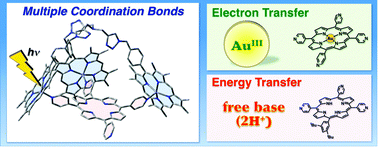A tripod zinc porphyrin (TPZn3) forms a stable 1 ∶ 1 complex with gold(III) tetra(4-pyridyl)porphyrin (AuTPyP+) and free-base tris(4-pyridyl)porphyrin (2H-Py3P) in nonpolar solvents. The strong binding of TPZn3 with AuTPyP+ or 2H-Py3P results from the encapsulation of AuTPyP+ or 2H-Py3P inside the cavity of TPZn3 through multiple coordination bonds, as indicated by UV-vis-NIR, ESI-MS, 1H NMR, electrochemistry and computational studies. The binding constants of monomer zinc porphyrin (MPZn) with AuTPyP+ and 2H-Py3P drastically decrease as compared with TPZn3. Detailed photophysical studies have been carried out on these composites using laser flash photolysis as well as emission spectroscopy. The efficient quenching of the singlet excited state of TPZn3 occurs via a photoinduced electron-transfer pathway in the TPZn3–AuTPyP+ complex. In contrast, energy transfer occurs in the TPZn3–2H-Py3P complex due to the smaller driving force of the photoinduced electron-transfer pathway. Neither electron transfer nor energy transfer occurs from MPZn to AuTPyP+ under the same experimental conditions due to the small association constant of the monomer zinc porphyrin.

